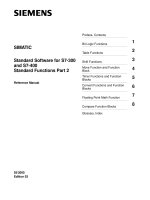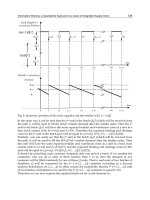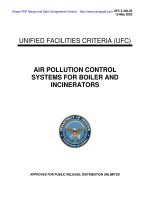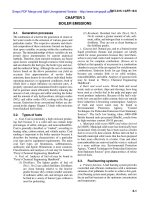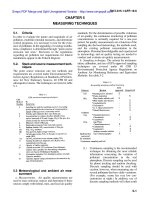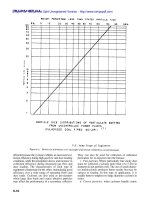SIEMENS - simatic standard software for S7-300 and S7-400 PID control ppt
Bạn đang xem bản rút gọn của tài liệu. Xem và tải ngay bản đầy đủ của tài liệu tại đây (285.87 KB, 42 trang )
Preface, Contents
Introduction
1
Parameter Assignment
2
Function Blocks
3
References
A
Glossary, Index
C79000-G7076-C516-01
Standard Software
for S7-300 and S7-400
PID Control
User Manual
SIMATIC
ii
Standard Software for S7-300 and S7-400 – PID Control
C79000 G7076 C516 01
This manual contains notices which you should observe to ensure your own personal safety, as well as to
protect the product and connected equipment. These notices are highlighted in the manual by a warning
triangle and are marked as follows according to the level of danger:
!
Danger
indicates that death, severe personal injury or substantial property damage will result if proper precautions are
not taken.
!
Warning
indicates that death, severe personal injury or substantial property damage can result if proper precautions are
not taken.
!
Caution
indicates that minor personal injury or property damage can result if proper precautions are not taken.
Note
draws your attention to particularly important information on the product, handling the product, or to a particular
part of the documentation.
The device/system may only be set up and operated in conjunction with this manual.
Only qualified personnel should be allowed to install and work on this equipment. Qualified persons are
defined as persons who are authorized to commission, to ground, and to tag circuits, equipment, and sys-
tems in accordance with established safety practices and standards.
Note the following:
!
Warning
This device and its components may only be used for the applications described in the catalog or the technical
description, and only in connection with devices or components from other manufacturers which have been
approved or recommended by Siemens.
This product can only function correctly and safely if it is transported, stored, set up, and installed correctly, and
operated and maintained as recommended.
SIMATICR and SINECR are registered trademarks of SIEMENS AG.
Third parties using for their own purposes any other names in this document which refer to
trademarks might infringe upon the rights of the trademark owners.
We have checked the contents of this manual for agreement with the
hardware and software described. Since deviations cannot be precluded
entirely, we cannot guarantee full agreement. However, the data in this
manual are reviewed regularly and any necessary corrections included in
subsequent editions. Suggestions for improvement are welcomed.
Technical data subject to change.
E Siemens AG 1996
Disclaimer of LiabilityCopyright E Siemens AG 1996 All rights reserved
The reproduction, transmission or use of this document or its contents is
not permitted without express written authority. Offenders will be liable for
damages. All rights, including rights created by patent grant or registration
of a utility model or design, are reserved.
Siemens AG
Automation Group
Industrial Automation Systems
Postfach 4848, D-90327 Nürnberg
Siemens Aktiengesellschaft C79000-G7076-C516
Safety Guidelines
Qualified Personnel
Correct Usage
Trademarks
iii
Standard Software for S7-300 and S7-400 – PID Control
C79000-G7076-C516-01
Preface
This manual supports you when working with the controller blocks of PID
Control.
The manual introduces you to the functions of the controller blocks and
familiarizes you with the user interface for assigning parameters to the
blocks. This user interface includes online help, that further supports you
when assigning parameters to the blocks.
This manual is intended for the following readers:
– S7 programmers
– Programmers of closed-loop control systems
– Operators
– Service personnel
PID Control
S7-300 and S7-400
Function
blocks
PID Control
Parameter
assignment user
interface
PID Control
Electronic
manual
PID Control
The “PID Control” software package includes the following components:
– The function blocks CONT_C, CONT_S and PULSEGEN.
– The parameter assignment user interface for configuring the controller
blocks.
– The manual consisting mainly of a description of the function blocks.
Purpose
Audience
Structure of
“PID Control”
iv
Standard Software for S7-300 and S7-400 – PID Control
C79000-G7076-C516-01
Provides you with an overview of PID Control
Chapter
1
Explains how to call the parameter assignment user interface
Chapter
2
Describes the function blocks FB 41 “CONT_C”, FB 42 “CONT_S”
and FB 43 “PULSEGEN”
Chapter
3
This manual is designed as a reference work providing you with the
information you require about PID Control. Depending on your experience,
you may well need further information that can be found in the manuals /70/,
/71/, /100/, /101/, /231/, /232/, /234/.
If you have any questions regarding the use or application of PID Control,
please contact the Siemens representative in your area.
You will find a list of addresses in the Appendix “SIEMENS Worldwide“ in
the “S7-400 Programmable Controller, Hardware and Installation” manual.
If you have any questions or comments on this manual, please fill out the
remarks form at the end of the manual and return it to the address shown on
the form. We would be grateful if you could also take the time to answer the
questions giving your personal opinion of the manual.
Siemens also offers a number of training courses to introduce you to the
SIMATIC S7 automation system. Please contact your regional training center
or the central training center in Nuremberg, Germany for details.
Tel. +49-911-985-3154.
Content of the
Manual
Further
Information
Additional
Assistance
Preface
v
Standard Software for S7-300 and S7-400 – PID Control
C79000-G7076-C516-01
Contents
1 Introduction 1-1. . . . . . . . . . . . . . . . . . . . . . . . . . . . . . . . . . . . . . . . . . . . . . . . . . . . . . . . . . . . .
2 Parameter Assignment 2-1. . . . . . . . . . . . . . . . . . . . . . . . . . . . . . . . . . . . . . . . . . . . . . . . . . .
3 Function Blocks 3-1. . . . . . . . . . . . . . . . . . . . . . . . . . . . . . . . . . . . . . . . . . . . . . . . . . . . . . . . .
3.1 Continuous Control with FB41 “CONT_C” 3-2. . . . . . . . . . . . . . . . . . . . . . . . . . .
3.2 Step Control with FB42 “CONT_S” 3-9. . . . . . . . . . . . . . . . . . . . . . . . . . . . . . . . .
3.3 Pulse Generation with FB43 “PULSEGEN” 3-15. . . . . . . . . . . . . . . . . . . . . . . . . .
3.4 Example of Using PULSEGEN 3-24. . . . . . . . . . . . . . . . . . . . . . . . . . . . . . . . . . . . .
A References A-1. . . . . . . . . . . . . . . . . . . . . . . . . . . . . . . . . . . . . . . . . . . . . . . . . . . . . . . . . . . . . .
Index Index-1. . . . . . . . . . . . . . . . . . . . . . . . . . . . . . . . . . . . . . . . . . . . . . . . . . . . . . . . . . . . . . . . . .
vi
Standard Software for S7-300 and S7-400 – PID Control
C79000-G7076-C516-01
1-1
Standard Software for S7-300 and S7-400 – PID Control
C79000-G7076-C516-01
Introduction
The function blocks (FBs) of the PID Control package consist of controller
blocks for continuous control (CONT_C), for step control (CONT_S), and
the FB for pulse duration modulation (PULSEGEN).
The controller blocks implement a purely software controller with the block
providing the entire functionality of the controller. The data required for
cyclic calculation is stored in data blocks assigned to the FB. This allows the
FBs to be called as often as necessary.
FB PULSEGEN is used in conjunction with FB CONT_C to implement a
controller with a pulse output for proportional actuators.
A controller created with the FBs consists of a series of subfunctions that you
can activate or deactivate. In addition to the actual controller with its PID
algorithm, integrated functions are also available for processing the setpoint
and process variable and for adapting the calculated manipulated variable.
A controller implemented with the two controller blocks is not restricted to
any particular application. The performance of the controller and its
processing speed is only dependent on the performance of the CPU being
used.
With any given CPU, a compromise must be made between the number of
controllers and the frequency at which the individual controllers are
processed. The speed at which the control loops must be processed, in other
words, the more often the manipulated variables must be calculated per unit
of time, determines the number of controllers that can be installed (faster
loops mean less controllers).
There are no restrictions in terms of the type of process that can be
controlled. Both slow processes (temperatures, tank levels etc.) and very fast
processes (flow rate, motor speed etc.) can be controlled.
Note
The static behavior (gain) and the dynamic characteristics (time lag, dead
time, reset time etc.) of the process to be controlled have a significant
influence on the structuring and design of the controller and on the selection
of the dimensions of its static (P component) and its dynamic (I and D
components) parameters.
Precise knowledge of the type and characteristic data of the process to be
controlled is essential.
The Concept of
PID Control
Basic Functions
Applications
Process Analysis
1
1-2
Standard Software for S7-300 and S7-400 – PID Control
C79000-G7076-C516-01
Note
The characteristics of control loops are decided by the given physical
characteristics of the process or machine being controlled and can only be
modified in minor ways. Good control quality is only possible if you choose
the controller type most suited to your situation and adapt it to the time
response of the process.
You can create a controller (structuring, parameter assignment, and call in
the system program) largely without programming. Knowledge of STEP 7 is,
however, necessary.
The STEP 7 online help also provides you with information about the various
FBs.
PID Control is a subset of Standard Control. For further information about
the standard controller, refer to /350/.
Choice of
Controller
Creating the
Controller
Online Help
Further
Information
Introduction
2-1
Standard Software for S7-300 and S7-400 – PID Control
C79000-G7076-C516-01
Parameter Assignment
You call the parameter assignment user interface of PID Control under
Windows 95 using the following menu options:
S Start " SIMATIC " STEP 7 V3 " PID Control Parameter
Assignment
In the first dialog, you can either open an existing instance data block (DB)
for an FB41 “CONT_C” or FB42 “CONT_S” or create a new data block as
the instance data block. If you create a new instance data block, you will be
prompted to assign the instance DB to an FB.
FB43 “PULSEGEN” does not have a parameter assignment user interface.
You must set its parameters with STEP 7 tools.
Note
Using the parameter assignment user interface of PID Control, you can also
assign parameters for the integrated control of the CPU 314 IFM. In this
case, you create instance DBs that you assign to SFB41 or SFB42.
Online help is available in the parameter assignment user interface to support
you when you assign parameters to the controller blocks. You can call the
online help in three ways:
S Using the menu option Help " Contents
S By pressing the F1 key
S By clicking the Help button in the parameter assignment dialogs
Calling the
Parameter
Assignment User
Interface
Online Help
2
2-2
Standard Software for S7-300 and S7-400 – PID Control
C79000-G7076-C516-01
Parametrierung
3-1
Standard Software for S7-300 and S7-400 – PID Control
C79000-G7076-C516-01
Function Blocks
Note
The function blocks described in this chapter (FB41 to FB43) have only been
released for S7/C7 CPUs with cyclic interrupt levels.
Section Description Page
3.1 Continuous Control with FB41 “CONT_C” 3-2
3.2 Step Control with FB42 “CONT_S” 3-9
3.3 Pulse Generation with FB43 “PULSEGEN” 3-15
3.4 Example of Using PULSEGEN 3-24
Chapter
Overview
3
3-2
Standard Software for S7-300 and S7-400 – PID Control
C79000-G7076-C516-01
3.1 Continuous Control with FB41 “CONT_C”
FB “CONT_C” is used on SIMATIC S7 programmable controllers to control
technical processes with continuous input and output variables. During
parameter assignment, you can activate or deactivate subfunctions of the PID
controller to adapt the controller to the process.
You can use the controller as a PID fixed setpoint controller or in multi-loop
controls as a cascade, blending or ratio controller. The functions of the
controller are based on the PID control algorithm of the sampling controller
with an analog signal, if necessary extended by including a pulse generator
stage to generate pulse duration modulated output signals for two or three
step controllers with proportional actuators.
Apart from the functions in the setpoint and process value branches, the FB
implements a complete PID controller with continuous manipulated variable
output and the option of influencing the manipulated value manually.
In the following, you will find a detailed description of the subfunctions:
Setpoint Branch
The setpoint is entered in floating-point format at the SP_INT input.
Process Variable Branch
The process variable can be input in the peripheral (I/O) or floating-point
format. The CRP_IN function converts the PV_PER peripheral value to a
floating-point format of -100 to +100 % according to the following formula:
Output of CRP_IN = PV_PER
100
27648
The PV_NORM function normalizes the output of CRP_IN according to the
following formula:
Output of PV_NORM = (output of CRP_IN) PV_FAC + PV_OFF
PV_FAC has a default of 1 and PV_OFF a default of 0.
Error Signal
The difference between the setpoint and process variable is the error signal.
To suppress a small constant oscillation due to the manipulated variable
quantization (for example in pulse duration modulation with PULSEGEN), a
dead band is applied to the error signal (DEADBAND). If DEADB_W = 0,
the dead band is switched off.
PID Algorithm
The PID algorithm operates as a position algorithm. The proportional,
integral (INT), and derivative (DIF) actions are connected in parallel and can
be activated or deactivated individually. This allows P, PI, PD, and PID
controllers to be configured. Pure I and D controllers are also possible.
Introduction
Application
Description
Function Blocks
3-3
Standard Software for S7-300 and S7-400 – PID Control
C79000-G7076-C516-01
Manual Value
It is possible to switch over between a manual and an automatic mode. In the
manual mode, the manipulated variable is corrected to a manually selected
value. The integrator (INT) is set internally to LMN - LMN_P - DISV and
the derivative unit (DIF) to 0 and matched internally. This means that a
switchover to the automatic mode does not cause any sudden change in the
manipulated value.
Manipulated Value
The manipulated value can be limited to a selected value using the
LMNLIMIT function. Signaling bits indicate when a limit is exceeded by the
input variable.
The LMN_NORM function normalizes the output of LMNLIMIT according
to the following formula:
LMN = (output of LMNLIMIT) LMN_FAC + LMN_OFF
LMN_FAC has the default 1 and LMN_OFF the default 0.
The manipulated value is also available in the peripheral format. The
CRP_OUT function converts the floating-point value LMN to a peripheral
value according to the following formula:
LMN_PER = LMN
100
27648
Feedforward Control
A disturbance variable can be fed forward at the DISV input.
Complete Restart/Restart
FB41 “CONT_C” has a complete restart routine that is run through when the
input parameter COM_RST = TRUE is set.
During startup, the integrator is set internally to the initialization value
I_ITVAL. When it is called in a cyclic interrupt priority class, it then
continues to work starting at this value.
All other outputs are set to their default values.
The block does not check for errors internally. The error output parameter
RET_VAL is not used.
Modes
Error
Information
Function Blocks
3-4
Standard Software for S7-300 and S7-400 – PID Control
C79000-G7076-C516-01
PV_PER
SP_INT
CRP_IN
%
PV_NORM
DEADBAND
PV_IN
PV_FAC,
PV_OFF
PVPER_ON
-
+
PV
DEADB_W
X
GAIN
ER
0
1
INT
DIF
+
+
TI, INT_HOLD,
I_ITL_ON,
I_ITLVAL
TD, TM_LAG
P_SEL
LMN_P
I_SEL
DISV
LMN_I
LMN_D
D_SEL
0
1
0
1
0
1
0
1
LMNLIMIT
QLMN_HLM
QLMN_LLM
LMN
LMN_PER
CRP_OUT
%
LMN_NORM
MAN
MAN_ON
LMN_HLM,
LMN_LLM
LMN_FAC,
LMN_OFF
0.0
0.0
0.0
Figure 3-1 Block Diagram of CONT_C
Block Diagram
Function Blocks
3-5
Standard Software for S7-300 and S7-400 – PID Control
C79000-G7076-C516-01
Table 3-1 contains the description of the input parameters for FB41
“CONT_C”.
Table 3-1 Input Parameters (INPUT) for FB 41 “CONT_C”
Parameter
Data
Type
Range of
Values
Default Description
COM_RST BOOL FALSE
COMPLETE RESTART
The block has a complete restart routine that is processed when
the input “complete restart” is set.
MAN_ON BOOL TRUE
MANUAL VALUE ON
If the input “manual value on” is set, the control loop is
interrupted. A manual value is set as the manipulated value.
PVPER_ON BOOL FALSE
PROCESS VARIABLE PERIPHERAL ON
If the process variable is read from the I/Os, the input PV_PER
must be connected to the I/Os and the input “process variable
peripheral on” must be set.
P_SEL BOOL TRUE
PROPORTIONAL ACTION ON
The PID actions can be activated or deactivated individually in
the PID algorithm. The P action is on when the input
“proportional action on” is set.
I_SEL BOOL TRUE
INTEGRAL ACTION ON
The PID actions can be activated or deactivated individually in
the PID algorithm. The I action is on when the input “integral
action on” is set.
INT_HOLD BOOL FALSE
INTEGRAL ACTION HOLD
The output of the integrator can be “frozen” by setting the input
“integral action hold”.
I_ITL_ON BOOL FALSE
INITIALIZATION OF THE INTEGRAL ACTION
The output of the integrator can be connected to the input
I_ITL_VAL by setting the input “initialization of the integral
action on”.
D_SEL BOOL FALSE
DERIVATIVE ACTION ON
The PID actions can be activated or deactivated individually in
the PID algorithm. The D action is on when the input
“derivative action on” is set.
CYCLE TIME
>= 1ms
T#1s
SAMPLING TIME
The time between the block calls must be constant. The
“sampling time” input specifies the time between block calls.
SP_INT REAL
-100.0 100.
0 (%)
or phys.
value 1)
0.0
INTERNAL SETPOINT
The “internal setpoint” input is used to specify a setpoint.
PV_IN REAL
-100.0 100.
0 (%)
or phys.
value 1)
0.0
PROCESS VARIABLE IN
An initialization value can be set at the “process variable in”
input or an external process variable in floating point format can
be connected.
PV_PER WORD
W#16#00
00
PROCESS VARIABLE PERIPHERAL
The process variable in the I/O format is connected to the
controller at the “process variable peripheral” input.
Input Parameters
Function Blocks
3-6
Standard Software for S7-300 and S7-400 – PID Control
C79000-G7076-C516-01
Table 3-1 Input Parameters (INPUT) for FB 41 “CONT_C”, continued
Parameter DescriptionDefault
Range of
Values
Data
Type
MAN REAL
-100.0 100.
0 (%)
or phys.
value 2)
0.0
MANUAL VALUE
The “manual value” input is used to set a manual value using the
operator interface functions.
GAIN REAL 2.0
PROPORTIONAL GAIN
The “proportional value” input specifies the controller gain.
TI TIME
>= CYCLE
T#20s
RESET TIME
The “reset time” input determines the time response of the
integrator.
TD TIME >= CYCLE T#10s
DERIVATIVE TIME
The “derivative time” input determines the time response of the
derivative unit.
TM_LAG TIME >= CYCLE/2 T#2s
TIME LAG OF THE DERIVATIVE ACTION
The algorithm of the D action includes a time lag that can be
assigned at the “time lag of the derivative action” input.
DEADB_W REAL
>= 0.0 (%)
or phys.
value 1)
0.0
DEAD BAND WIDTH
A dead band is applied to the error. The “dead band width”
input determines the size of the dead band.
LMN_HLM REAL
LMN_LLM
100.0 (%)
or phys.
value 2)
100.0
MANIPULATED VALUE HIGH LIMIT
The manipulated value is always limited by an upper and lower
limit. The “manipulated value high limit”input specifies the
upper limit.
LMN_LLM REAL
-100.0
LMN_HLM
(%)
or phys.
value 2)
0.0
MANIPULATED VALUE LOW LIMIT
The manipulated value is always limited by an upper and lower
limit. The “manipulated value low limit”input specifies the
lower limit.
PV_FAC REAL 1.0
PROCESS VARIABLE FACTOR
The “process variable factor” input is multiplied by the process
variable. The input is used to adapt the process variable range.
PV_OFF REAL 0.0
PROCESS VARIABLE OFFSET
The “process variable offset” input is added to the process
variable. The input is used to adapt the process variable range.
LMN_FAC REAL 1.0
MANIPULATED VALUE FACTOR
The “manipulated value factor” input is multiplied by the
manipulated value. The input is used to adapt the manipulated
value range.
LMN_OFF REAL 0.0
MANIPULATED VALUE OFFSET
The “manipulated value offset” is added to the manipulated
value. The input is used to adapt the manipulated value range.
Function Blocks
3-7
Standard Software for S7-300 and S7-400 – PID Control
C79000-G7076-C516-01
Table 3-1 Input Parameters (INPUT) for FB 41 “CONT_C”, continued
Parameter DescriptionDefault
Range of
Values
Data
Type
I_ITLVAL REAL
-100.0 100.
0 (%)
or phys.
value 2)
0.0
INITIALIZATION VALUE OF THE INTEGRAL ACTION
The output of the integrator can be set at input I_ITL_ON. The
initialization value is applied to the input “initialization value of
the integral action”.
DISV REAL
-100.0 100.
0 (%)
or phys.
value 2)
0.0
DISTURBANCE VARIABLE
For feedforward control, the disturbance variable is connected to
input “disturbance variable”.
1) Parameters in the setpoint and process variable branches with the same unit
2) Parameters in the manipulated value branch with the same unit
Table 3-2 contains the description of the output parameters for FB41
“CONT_C”.
Table 3-2 Output Parameters (OUTPUT) for FB 41 “CONT_C”
Parameter
Data
Type
Range of
Values
Default Description
LMN REAL 0.0 MANIPULATED VALUE
The effective manipulated value is output in floating point
format at the “manipulated value” output.
LMN_PER WORD W#16#0000 MANIPULATED VALUE PERIPHERAL
The manipulated value in the I/O format is connected to the
controller at the “manipulated value peripheral” output.
QLMN_HLM BOOL FALSE HIGH LIMIT OF MANIPULATED VALUE REACHED
The manipulated value is always limited to an upper and
lower limit. The output “high limit of manipulated value
reached” indicates that the upper limit has been exceeded.
QLMN_LLM BOOL FALSE LOW LIMIT OF MANIPULATED VALUE REACHED
The manipulated value is always limited to an upper and
lower limit. The output “low limit of manipulated value
reached” indicates that the lower limit has been exceeded.
LMN_P REAL 0.0 PROPORTIONAL COMPONENT
The “proportional component” output contains the
proportional component of the manipulated variable.
LMN_I REAL 0.0 INTEGRAL COMPONENT
The “integral component” output contains the integral
component of the manipulated value.
LMN_D REAL 0.0 DERIVATIVE COMPONENT
The “derivative component” output contains the derivative
component of the manipulated value.
Output
Parameters
Function Blocks
3-8
Standard Software for S7-300 and S7-400 – PID Control
C79000-G7076-C516-01
Table 3-2 Output Parameters (OUTPUT) for FB 41 “CONT_C”, continued
Parameter DescriptionDefault
Range of
Values
Data
Type
PV REAL 0.0 PROCESS VARIABLE
The effective process variable is output at the “process
variable” output.
ER REAL 0.0 ERROR SIGNAL
The effective error is output at the “error signal” output.
Function Blocks
3-9
Standard Software for S7-300 and S7-400 – PID Control
C79000-G7076-C516-01
3.2 Step Control with FB42 “CONT_S”
FB42 “CONT_S” is used on SIMATIC S7 programmable logic controllers to
control technical processes with digital manipulated value output signals for
integrating actuators. During parameter assignment, you can activate or
deactivate subfunctions of the PI step controller to adapt the controller to the
process.
You can use the controller as a PI fixed setpoint controller or in secondary
control loops in cascade, blending or ratio controllers, however not as the
primary controller. The functions of the controller are based on the PI control
algorithm of the sampling controller supplemented by the functions for
generating the binary output signal from the analog actuating signal.
Apart from the functions in the process value branch, the FB implements a
complete PI controller with a digital manipulated value output and the option
of influencing the manipulated value manually. The step controller operates
without a position feedback signal.
In the following you will find the description of the partial functions:
Setpoint Branch
The setpoint is entered in floating-point format at the SP_INT input.
Process Variable Branch
The process variable can be input in the peripheral (I/O) or floating-point
format. The CRP_IN function converts the PV_PER peripheral value to a
floating-point format of -100 to +100 % according to the following formula:
Output of CRP_IN = PV_PER
100
27648
The PV_NORM function normalizes the output of CRP_IN according to the
following formula:
Output of PV_NORM = (output of CRP_IN) PV_FAC + PV_OFF
PV_FAC has a default of 1 and PV_OFF a default of 0.
Error Signal
The difference between the setpoint and process variable is the error signal.
To suppress a small constant oscillation due to the manipulated variable
quantization (for example due to a limited resolution of the manipulated
value by the actuator valve), a dead band is applied to the error signal
(DEADBAND). If DEADB_W = 0, the dead band is switched off.
Introduction
Application
Description
Function Blocks
3-10
Standard Software for S7-300 and S7-400 – PID Control
C79000-G7076-C516-01
PI Step Algorithm
The FB operates without a position feedback signal. The I action of the PI
algorithm and the assumed position feedback signal are calculated in one
integrator (INT) and compared with the remaining P action as a feedback
value. The difference is applied to a three-step element (THREE_ST) and a
pulse generator (PULSEOUT) that creates the pulses for the actuator. The
switching frequency of the controller can be reduced by adapting the
threshold on of the three-step element.
Feedforward Control
A disturbance variable can be fed forward at the DISV input.
Complete Restart/Restart
FB42 “CONT_S” has a complete restart routine that is run through when the
input parameter COM_RST = TRUE is set.
All other outputs are set to their default values.
The block does not check for errors internally. The error output parameter
RET_VAL is not used.
Modes
Error
Information
Function Blocks
3-11
Standard Software for S7-300 and S7-400 – PID Control
C79000-G7076-C516-01
+
PV_PER
SP_INT
CRP_IN
%
PV_NORM
DEADBAND
PV_IN
PV_FAC
PV_OFF
PVPER_ON
–
+
PV
DEADB_W
X
GAIN
ER
0
1
THREE_ST
INT
LMNR_SIM
LMNS_ON
LMNUP
LMNDN
PULSEOUT
AN
D
AN
D
AN
D
AN
D
LMNR_HS
LMNR_LS
QLMNDN
QLMNUP
100.0
0.0
–100.0
0.0
1/MTR_TM
X
INT
LMNLIMIT
OR
1
0.0
+
–
0.0
LMNS_ON
0
1
0
1
0
0
1
1
0
X
1/TI
1
0
+
DISV
–
adaptiv
LMNRS_ON
,LMNRSVAL
100.0 ,
0.0
MTR_TM
PULSE_TM,
BREAK_TM
Figure 3-2 Block Diagram of CONT_S
Block Diagram
Function Blocks
3-12
Standard Software for S7-300 and S7-400 – PID Control
C79000-G7076-C516-01
Table 3-3 contains the description of the input parameters for FB42
“CONT_S”.
Table 3-3 Input Parameters (INPUT) for FB 42 “CONT_S”
Parameter
Data
Type
Range of
Values
Default Description
COM_RST BOOL FALSE COMPLETE RESTART
The block has a complete restart routine that is processed
when the input “complete restart” is set.
LMNR_HS BOOL FALSE HIGH LIMIT OF POSITION FEEDBACK SIGNAL
The “actuator at upper limit stop” signal is connected to the
“high limit of position feedback signal” input.
LMNR_HS=TRUE means the actuator is at upper limit
stop.
LMNR_LS BOOL FALSE LOW LIMIT OF POSITION FEEDBACK SIGNAL
The “actuator at lower limit stop” signal is connected to the
“low limit of position feedback signal” input.
LMNR_LS=TRUE means the actuator is at lower limit stop.
LMNS_ON BOOL FALSE MANUAL ACTUATING SIGNALS ON
The actuating signal processing is switched to manual at the
“manual actuating signals on” input
LMNUP BOOL FALSE ACTUATING SIGNALS UP
With manual actuating value signals, the output signal
QLMNUP is set at the input “actuating signals up”.
LMNDN BOOL FALSE ACTUATING SIGNALS DOWN
With manual actuating value signals, the output signal
QLMNDN is set at the input “actuating signals down”.
PVPER_ON BOOL FALSE PROCESS VARIABLE PERIPHERAL ON
If the process variable is read in from the I/Os, the input
PV_PER must be connected to the I/Os and the input
“process variable peripheral on” must be set.
CYCLE TIME
>= 1ms
T#1s SAMPLING TIME
The time between the block calls must be constant. The
“sampling time” input specifies the time between block
calls.
SP_INT REAL
-100.0 100.0
(%)
or phys. value
1)
0.0 INTERNAL SETPOINT
The “internal setpoint” input is used to specify a setpoint.
PV_IN REAL -100.0 100.0
(%)
or phys. value
1)
0.0 PROCESS VARIABLE IN
An initialization value can be set at the “process variable in”
input or an external process variable in floating point format
can be connected.
PV_PER WORD W#16#0000 PROCESS VARIABLE PERIPHERAL
The process variable in the I/O format is connected to the
controller at the “process variable peripheral” input.
Input Parameters
Function Blocks
3-13
Standard Software for S7-300 and S7-400 – PID Control
C79000-G7076-C516-01
Table 3-3 Input Parameters (INPUT) for FB 42 “CONT_S”, Fortsetzung
Parameter DescriptionDefault
Range of
Values
Data
Type
GAIN REAL 2.0 PROPORTIONAL GAIN
The “proportional gain” input sets the controller gain.
TI TIME
>= CYCLE
T#20s RESET TIME
The “reset time” input determines the time response of the
integrator.
DEADB_W REAL 0.0 100.0
(%)
or phys. value
1)
1.0
DEAD BAND WIDTH
A dead band is applied to the error. The “dead band width”
input determines the size of the dead band.
PV_FAC REAL 1.0 PROCESS VARIABLE FACTOR
The “process variable factor” input is multiplied by the
process variable. The input is used to adapt the process
variable range.
PV_OFF REAL 0.0 PROCESS VARIABLE OFFSET
The “process variable offset” input is added to the process
variable. The input is used to adapt the process variable
range.
PULSE_TM TIME >= CYCLE T#3s MINIMUM PULSE TIME
A minimum pulse duration can be assigned with the
parameter “minimum pulse time”.
BREAK_T
M
TIME >= CYCLE T#3s MINIMUM BREAK TIME
A minimum break duration can be assigned with the
parameter “minimum break time”.
MTR_TM TIME >= CYCLE T#30s MOTOR ACTUATING TIME
The time required by the actuator to move from limit stop to
limit stop is entered at the “motor actuating time” parameter.
DISV REAL -100.0 100.0
(%)
or phys. value
2)
0.0 DISTURBANCE VARIABLE
For feedforward control, the disturbance variable is
connected to input “disturbance variable”.
1) Parameters in the setpoint and process variable branches with the same unit
2) Parameters in the manipulated value branch with the same unit
Function Blocks
3-14
Standard Software for S7-300 and S7-400 – PID Control
C79000-G7076-C516-01
Table 3-4 contains the description of the output parameters for FB42
“CONT_S”.
Table 3-4 Output Parameters (OUTPUT) for FB42 “CONT_S”
Parameter
Data
Type
Range of
Values
Default Description
QLMNUP BOOL FALSE ACTUATING SIGNAL UP
If the output “actuating signal up” is set, the actuating valve
is opened.
QLMNDN BOOL FALSE ACTUATING SIGNAL DOWN
If the output “actuating signal down” is set, the actuating
valve is opened.
PV REAL 0.0 PROCESS VARIABLE
The effective process variable is output at the “process
variable” output.
ER REAL 0.0 ERROR SIGNAL
The effective error is output at the “error signal” output.
Output Parameters
Function Blocks
3-15
Standard Software for S7-300 and S7-400 – PID Control
C79000-G7076-C516-01
3.3 Pulse Generation with FB43 “PULSEGEN”
FB43 “PULSEGEN” is used to structure a PID controller with pulse output
for proportional actuators
Using FB43 “PULSEGEN”, PID two or three step controllers with pulse
duration modulation can be configured. The function is normally used in
conjunction with the continuous controller ~CONT_C”.
LMN
PULSEGEN
INV
CONT_C
The PULSEGEN function transforms the input variable INV ( = manipulated
value of the PID controller) by modulating the pulse duration into a pulse
train with a constant period, corresponding to the cycle time at which the
input variable is updated and which must be assigned in PER_TM.
The duration of a pulse per period is proportional to the input variable. The
cycle assigned to PER_TM is not identical to the processing cycle of the FB
“PULSEGEN”. The PER_TM cycle is made up of several processing cycles
of FB “PULSEGEN”, whereby the number of FB “PULSEGEN” calls per
PER_TM cycle is the yardstick for the accuracy of the pulse duration
modulation.
t
INV
QPOS_P
(LMN)
0
50
100
1
0
t
PER_TM
PULSEGEN cycle
30
50
80
(= CONT_C cycle)
Figure 3-3 Pulse Duration Modulation
Introduction
Application
Description
Function Blocks



